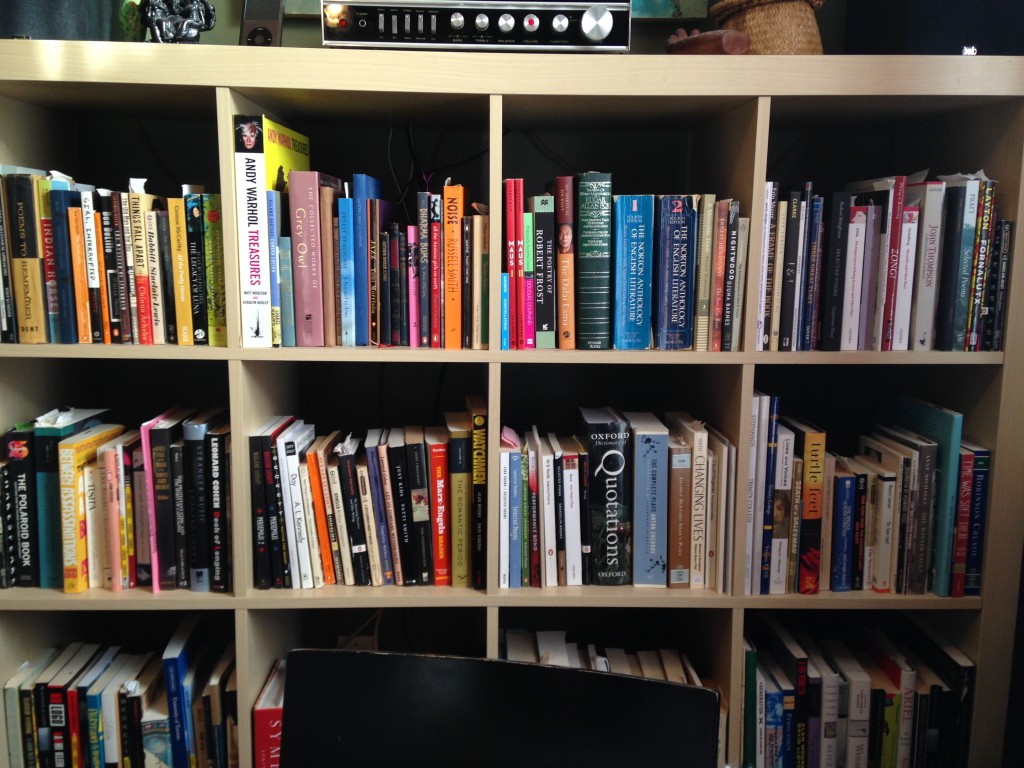 Photo: Author’s bookshelf (one).
Photo: Author’s bookshelf (one).
At the risk of sounding like a broken record, I am a bibliophile through and through, and for me this still means good ol’ paper books. This past year we moved into a space about double our previous bachelor apartment, and for the first time, we are able to house all of our books on numerous shelves covering each and every wall. We have relatively the same number of books, it’s just that in the past they were piled in stacks – on chairs, on the floor, on top of shelves already two-books deep…we still have that now, although the volume we’ve been able to accommodate has greatly increased (finally, no more books in boxes in a basement somewhere!). Despite some of the impracticalities of owning this many books, I am proud of our personal library, and cherish it deeply. Being able to find and afford enough space to be surrounded by our favourite books took time and effort, and yet it was of huge significance to us – books make a space feel like home. In this case, wallpapering the walls of our house, surrounding us constantly, our shelved books do become a sort of furnishing, a part of the house itself. So, where am I going with this and how does it relate to reading? Perhaps it is my absolute love of paper books that has led me to ignore digital books and e-readers. I don’t want to get into a reductive argument here about the relative value of either medium – as has been said time and again, it’s not productive, nor is it particularly stimulating. I don’t feel a sense of bibliophilic superiority, or some kind of proud technophobia or ludditeism. I simply can’t really be bothered. Sometimes, my lack of basic awareness and understanding of e-books can actually make me feel out of touch and behind the times (see last week’s blog post). For the most part though, I just don’t think about them – they aren’t a part of my reading ecology. I believe one of the reasons for this that I have touched on before is partly to do with physicality – not simply during the act of reading, but also books as objects themselves. There is a presence that is missing in what John Maxwell calls this “website in a wrapper” (39). Something in me rebels against them. When I began considering what, if anything, I actually did consume on a screen, all that came to mind is what I ‘read’ on the screen of my phone. Again, I have ‘read’ in scare quotes here because, like Andrew Piper said, I’m unsure if I can in fact call this ‘reading’ (46). Checking emails, perusing social media, glancing through online articles…all of this is something; I’m just not sure what? I don’t associate these activities with the same quality as reading a book. They are fleeting, less important interactions, more about pure, quick consumption, forgotten almost as soon as it is taken in. I print off anything that I might need to read for my classes, and perhaps in a related fashion, I still take all my notes by hand.
To be honest, I haven’t been especially reflexive before regarding my preference for printed books. As something that works for me, I’ve sort of just gone with it. I am aware that as a soon-to-be librarian, it would be helpful for me to have a better understanding of what e-books are, how they work, and why others do like to read them – if only as basic sound professional practice. I guess if I consider it, a lot of my reading habits and preferences do come down to an issue of presence and absence. When I am at home, I can look up at my books, I can gesture to them during conversation, pull one down, lend it out, put it aside for later, or place it somewhere for special consideration (my bedside table is the space for the honoured ‘book (or five) of the moment’). Come to think of it, a large part of my reading practices seem to be informed by this spatial hierarchy of meaning, by being able to manipulate books as objects in space (on a macro level), and on a micro level, being able to manipulate pages within them. I never annotate books when I read them, the most I might do is sticky note pages I want to return to. Still, knowing how far the section I’m reading is from the start or end, what the visual markers are, all of this helps me to imprint pages in my memory, to hold onto them. The covers of books, the tone and quality of their paper, the feel of them in my hand, these things help me navigate my surroundings and feel at home while reading. I always laugh when people describe the benefits of travelling with an e-reader, as it provides you with an immense array of reading options, and takes up so little space. Both my partner and I have been known to carry upwards of three and four books with us at a time (on trips whose lengths certainly don’t warrant that much reading material). Again, for us, this is okay. We don’t mind sacrificing the space. It’s worth it. Part of this silly, uncompromising stubbornness in the face of technological options makes me realize, just maybe, why I still prefer to read how I do – because it feels good. At some basic level, reading in this way gives me pleasure, and despite attempts, reading electronically just doesn’t compare.
References:
Maxwell, John W. (2013). E-book logic: We can do better. Papers of the Bibliographical Society of Canada. 51 (1): 29-47.
Piper, Andrew (2012). Turning the page (roaming, zooming, streaming). In Book was there: Reading in electronic times (pp. 45-61). Chicago: The University of Chicago Press.
